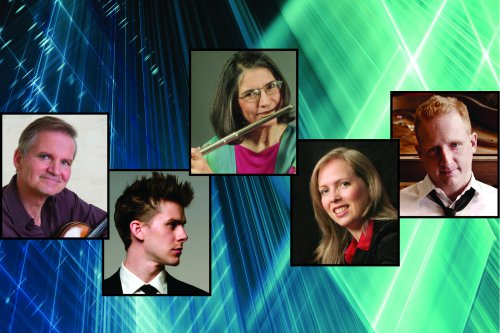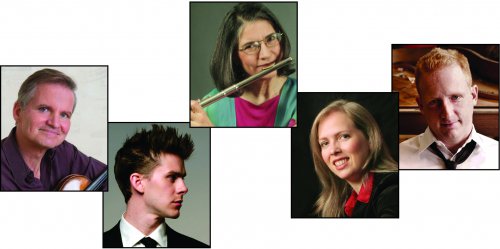Da Capo Chamber Players: Milton Babbitt Centennial Da Capo
An intimate, happy celebration of contemporary classical chamber music.

Curtis Macomber, Chris Gross, Patricia Spencer, Meighan Stoops and Steven Beck (Couresy of The Da Capo Chamber Players)
[avatar user=”Jean Ballard Terepka” size=”96″ align=”left” ] Jean Ballard Terepka, Music Critic[/avatar]Joined by percussionist John Ferrari and conductor Jeffrey Means, the five members of the Da Capo Chamber Players – Curtis Macomber/violin, Chris Gross/cello, Patricia Spencer/flute, Meighan Stoops/clarinet and Steven Beck/piano – recently presented a concert inspired by the vibrant, important music of Milton Babbitt (1916-2011) on the occasion of the centennial of his birth. One piece was written by Babbitt himself, but all the other pieces, ranging in date from 1981 to 2013, were written by contemporary composers who at one point or another had studied with Babbitt at either Princeton or Juilliard.
Chance and weather conspired to make the audience exceptionally small: there were barely 40 people in attendance. This is too bad – because the music was splendid – but the feel of an intimate chamber music salon turned out to be oddly appropriate for celebration of the work of a composer whose music was marked by a sense of personal invitation. The small audience consisted mostly of the musicians and composers’ friends and colleagues; there was an atmosphere of affectionate camaraderie throughout the evening.
The evening opened with Paul Lansky’s Odd Moments, a 14-minute piece written over a period of nearly 11 years and completed in 2010. In this piece, the Da Capo musicians seem almost to dance with each other: the work opens with something simple sounding – a melody of engaging sweetness – that unfolds into a complex exploration of ways in which the five instruments can engage with each other. Lansky himself described Odd Moments as “an exuberant and busy job for five players,” and it’s a good description: with fluid ease and unerring attentiveness to each other, the musicians engage in rhythmic and melodic play, setting up the music as constant movement on a continuum between urgency and lyricism. The piece ends almost dreamily: the original sweetness is recalled, but the complexities that have held sway in the meantime render the conclusion poignant.
The second piece – just six minutes long – was Judith Shatin’s Gazebo Music for flute and cello. Written in 1981 as an American Dance Festival (Durham, North Carolina) site-specific accompaniment for dancers emerging from woods, approaching a gazebo and then retreating for repose in magnolia trees, the piece evokes nymphs, mysteries, and pastoral magic. Long notes and lines – for both instruments – alternate with short interludes of delicate precision; plaintiveness alternates with teasing, and langor with weightlessness. The single concluding high note releases intimacy into mystery.
The third piece, Arie Da Capo, was the single Babbitt piece on the program. Babbitt wrote the work in 1973 “as a grateful dedication to the Da Capo Chamber Players” and designed it to incorporate an “aria” for each of the five Da Capo instruments, each with its own transformations and reorientations – in Babbitt’s vocabulary – according to its connections with the other four instruments. The result is quintessential Babbitt. It is a dense and difficult work; it requires virtuosic musicians; it expects and exacts alert attentiveness from its audience. And then it offers lovely rewards: it is an entrance into a fully developed and complex world of musical relationships, each glimpsed and explored in small, demanding bursts. Conducted by Means, the Da Capo musicians played the wildly demanding music with unerring clarity.

Curtis Macomber, Chris Gross, Patricia Spencer, Meighan Stoops and Steven Beck (Couresy of The Da Capo Chamber Players)
After a brief intermission, the program resumed with A Glimpse of Trembling Refraction, composed in 2013 by Wei-Chieh Lin, the youngest composer on the program, born in 1982. Though the work is composed for piano and cello, it is really an eight-minute-long cello-centric celebration. The work explores the cello’s sounds – beautiful and unbeautiful alike – and stretches traditional ways of playing to their greatest extremes from violence to barely audible delicacy; the music wanders wildly without ever becoming untethered … until the dense push and pull of exploration ends in a release into such quiet that it seems like a commitment to a different kind of sound-space.
Jonathan Dawe’s 2007 Super Mozart Fractals for clarinet and piano – the program’s shortest piece, just four minutes long – was also its most historically referential and funny. As Dawe indicated in the program notes, this piece takes up several of Mozart’s “little known pedagogical artifacts” and quite literally plays with them, with “a more contemporary extra-human athleticism.” The result is an exercise in fractured time-travel, an elegant, angular bit of witty bravura – incredibly difficult to play – that carries musicians and listeners alike right to a heady charm-spot where humour, intellect and inspiration converge. Dawe was in the audience to receive applause and to extend his own thanks to the musicians.
The program concluded with Fred Lerdahl’s two movement Time after Time composed in 2000 for flute, clarinet, violin, cello, piano and percussion. Means conducted and the Da Capo quintet was joined by Ferrari. This ambitious 20-minute piece organizes itself around examinations of the ways in which simple ideas can be made to spiral up and down, moving in each cycle towards greater complexity. This evolution and multiplication process conveys very tangible presentations of movement through space. In each of the two similarly organized movements, each instrument is pushed to its own limits even as they all retain their connectedness to each other. In spite of the music’s demanding urgency, multiplicity’s creation has moments of both lush lyricism and near symphonic grandeur. The final slow decrescendo from a huge concluding demonstration of the instruments’ combined power to something much more speculative suggests worlds of continued creative possibility. Lerdahl, like Dawe, was in the audience to receive and offer applause.
Different as the evening’s five composers – Lansky, Shatin, Lin, Dawe and Lerdahl – are from each other, they do share some key features. Though “modern” and “contemporary,” they do not ask performers to radically change their instruments: Lin might have had the pianist pluck the piano’s strings, but instruments were not turned upside down or pulled away from their histories and origins. In that sense, these contemporary composers are conservative. But as students of Babbitt’s, they all share a sensibility of intellectual liveliness and expectations of intensely civilized camaraderie with audiences and listeners; they are all committed to an aesthetic of cerebrality that is generously inviting.
This Babbitt spirit of welcome was at the happy center of the Da Capo Chamber Players’ centennial celebration of the composer’s music and influence.
Da Capo Chamber Players: Milton Babbitt Centennial Da Capo (November 21, 2016)
Merkin Concert Hall, 129 West 67th Street, in Manhattan
For more information: contact http://www.gingarts.com/artists/da-capo-chamber-players/
Running time: one hour and 45 minutes with one intermission





Leave a comment